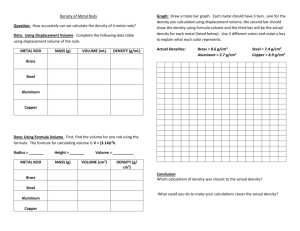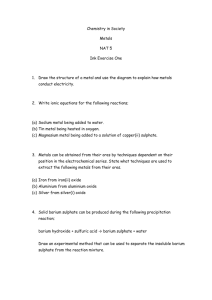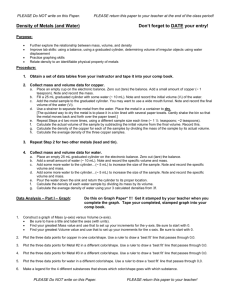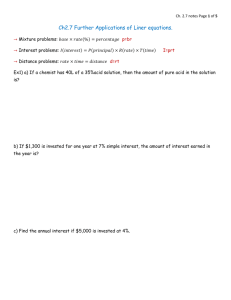Self Designed Experiment with Batteries
advertisement
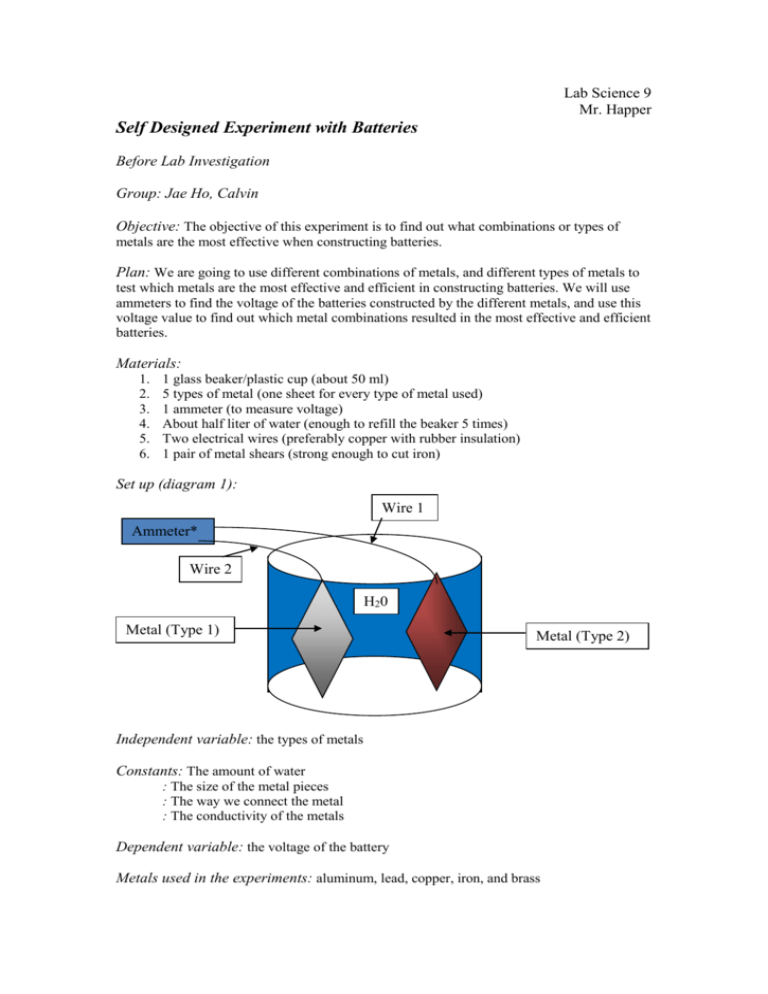
Lab Science 9 Mr. Happer Self Designed Experiment with Batteries Before Lab Investigation Group: Jae Ho, Calvin Objective: The objective of this experiment is to find out what combinations or types of metals are the most effective when constructing batteries. Plan: We are going to use different combinations of metals, and different types of metals to test which metals are the most effective and efficient in constructing batteries. We will use ammeters to find the voltage of the batteries constructed by the different metals, and use this voltage value to find out which metal combinations resulted in the most effective and efficient batteries. Materials: 1. 2. 3. 4. 5. 6. 1 glass beaker/plastic cup (about 50 ml) 5 types of metal (one sheet for every type of metal used) 1 ammeter (to measure voltage) About half liter of water (enough to refill the beaker 5 times) Two electrical wires (preferably copper with rubber insulation) 1 pair of metal shears (strong enough to cut iron) Set up (diagram 1): Wire 1 Ammeter* Wire 2 H20 Metal (Type 1) Metal (Type 2) Independent variable: the types of metals Constants: The amount of water : The size of the metal pieces : The way we connect the metal : The conductivity of the metals Dependent variable: the voltage of the battery Metals used in the experiments: aluminum, lead, copper, iron, and brass Procedure for 1st experiment (aluminum and brass) I. a. Prepare a beakers/cup, fill with approximately 40 ml of water b. Cut sheets of metal (aluminum and brass) with the metal shears so that there is 1 piece of 1 by 3 inch metal for each type of metal c. File the edges and corners of the metal so that there is less risk of injury during the experiment d. Place 2 pieces of prepared metal, one piece of aluminum and one piece of brass, vertically into the beaker and keep them separated e. Connect the piece of aluminum to the ammeter wire using an electrical wire, and do the same for the piece of brass (diagram 1 on page 1 for guidance) f. Turn the ammeter dial to the voltage setting, wait for the value to stabilize at a certain value and record the voltage II. Procedure for other experiments a. Same procedure as 1st experiment except with the different metals b. Continue this procedure for at least 10 experiments with different metals Expectations: We expect the copper and brass will result in the highest voltages, for copper has a high conductivity, and brass is an alloy of copper and zinc. Additionally, we predict the lead and aluminum will perform the worst, due to lead’s terrible conductivity, and aluminum is only a semi-conductor. Our hypothesis is that conductivity will affect the effectiveness, strength, and efficiency of the different battery types greatly. Graph of expected values (5 combinations of metals): V O L T A G E Copper & Brass Brass & Aluminum Iron & Copper Lead & Aluminum Types/Combinations of Metals Aluminum & Copper Self Designed Experiment with Batteries After Lab Investigation Collected Data: Battery Experiment Data 1 Metal Combination Brass & Aluminum Copper & Aluminum Lead & Aluminum Iron & Aluminum Iron & Copper Iron & Lead Iron & Brass Brass & Copper Brass & Lead Copper & Lead Voltage 0.290 0.287 0.159 0.115 0.257 0.170 0.282 0.102 0.030 0.030 Side note: Uncertainty (+/- 0.003) because of instability of values on ammeter. Graph of Collected Data: Voltage V o l t a g e ( V 0.350 0.300 0.250 0.200 0.150 0.100 0.050 0.000 Voltage ) Metal Combinations (5 types of metal) Evaluation after Lab Investigation: The data collected in our lab experiments was completely different than what we had predicted in our expectations and hypotheses. From the data collected in the experiments, it is evident that the types of metal used inside of this homemade battery were crucial to the voltage of the battery. Throughout our ten experiments with different combinations of metals, we found that brass and aluminum, copper and aluminum, iron and copper, and iron and brass produced the strongest electrical output. Surprisingly, we found that copper and brass produced only 0.102 volts of current, for copper is an excellent conductor of electricity. Additionally, brass is an alloy of copper and zinc, usually about 67 percent copper. To investigate further, we tested copper and copper together, and found that the battery produced only 0.03 volts. In addition, iron and aluminum proved to form excellent battery combinations with brass and copper. After testing lead with several other metals, we found that it was a terrible component for batteries, and resulted in very little electrical output. On the second day of experiments, we found that the iron pieces had rusted slightly, and the copper had formed a coat of greenish copper oxide on the outside. Unfortunately, these metal pieces may have thrown off the voltages of the batteries, and as a result, the data may not have been as accurate as possible. I would recommend drying the metals completely after every experiment, thus making the data more accurate. Evidently, the types of metals included in the battery drastically affected the amount of electrical current outputted by the battery. The metal combinations of copper and aluminum, iron and copper, brass and aluminum, and iron and brass produced the largest amounts of electrical current. Additionally, copper, aluminum, iron, and brass are all known as decent conductors of electricity, so conductivity of the metals does seem to affect the electrical output of the battery. In conclusion, our data supported our hypothesis for the most part, but the case with the copper and brass was an exception. More investigation and research on the metals, especially copper and brass, would improve our investigation on batteries greatly.

